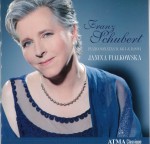 Schubert – Piano Sonatas D664 and D894
Schubert – Piano Sonatas D664 and D894
Janina Fialkowska
ATMA ACD 22681
These two sonatas are dissimilar works, coming as they do from very different periods in Schubert’s life, albeit only seven years apart. The earlier Sonata in A Major is thoroughly pleasant with familiar echoes of Mozart and Haydn throughout. Altogether, it’s a finely crafted piece with a conventional three-movement structure and competently developed ideas.
While this description sounds bland, the beauty of Fialkowska’s approach is that she actually understands this and refuses to make more of the sonata than it deserves. Instead, she plays each movement with a strict no-nonsense approach leaving aside the over-romanticized interpretations attempted by some other pianists. She finds just the right balance between the technical requirements of the music and the smaller but clearly still-emerging voice of the composer in this musical form.
In the second sonata (G major) Fialkowska acknowledges the more substantial content. Here, Schubert places technical demands in greater service of the music’s development allowing the performer new heights of invention and emotion. The opening movement is huge and Fialkowska plays it with a sustained commitment to holding its thematic ideas together until the triple forte ending.
The succeeding slow movement weaves a tender melody around a more stormy response which Fialkowska never allows to grow out of control. After a light dance movement, she plays through a fourth and final movement that ends quietly with a tasteful sense of anti-climax.
Throughout both sonatas, Fialkowska’s seasoned touch is a tribute to her mature understanding of Schubert’s actual intentions. Fialkowska’s Schubert is the real McCoy.



